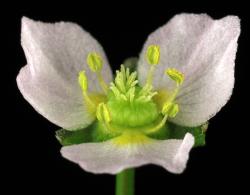Aquatic (freshwater) emergent or floating-leaved herbs, perennial or annual (rarely), with milky sap; rhizomatous or stoloniferous; vessels absent. Roots adventitious, fibrous. Hermaphrodite, monoecious, polygamomonoecious, or dioecious (rarely). Leaves basal, sheathing, simple, petiolate or sessile, floating, often heterophyllous. Leaf-lamina lobed or non-lobed, margin entire, an apical pore present; venation reticulate, prominent primary veins parallel, secondary veins reticulate. Inflorescence a whorled scape, raceme, panicle, umbel (rarely) or solitary, bracteate, erect or rarely floating. Flowers perfect or imperfect, actinomorphic; perianth hypogynous in two alternate whorls, sepals 3 persistent, petals 3 deciduous. Androecium 0–6–9 to many stamens in 1 or more whorls, free; anthers tetrasporangiate, 2-loculed, basifixed or versatile, extrorse or latrose dehiscence, opening by longitudinal slits; pollination syndrome entomophilous. Gynoecium 0–3–6 to many, ovary superior; carpels free or united at base, in 1 whorl or spiralled, apocarpic or occasionally with two anatropous ovules, or many (Hydrocleys), placentation basal or laminar, styles apical or lateral, persistent; carpel nectariferous region or septal nectaries present. Fruit a single whorl of laterally compressed achenes (forming a ring or cluster), or a follicle. Seeds uncinate-curved, with a horseshoe-shaped embryo, non-endospermic; starch.
Alismataceae is part of a group of families known as the alismatids, a large radiation of plants exhibiting numerous adaptations for life in water, both fresh and marine. This treatment follows Les & Tippery (2013) by including Hydrocleys in the Alismataceae, giving a total of about 113 species of herbs in 17 genera. The latter genus was previously placed by Healy & Edgar (1980) in the Butomaceae and by some recent floras in the Limnocharitaceae (Haynes & Holm-Neilsen 1992, Jacobs & McColl 2011).
Based on molecular phylogenies (Les & Cleland 1997, Iles et al. 2013, Ross et al. 2016) the Alismataceae are placed in a well-supported clade known as the ‘petaloid clade’, also including Butomaceae and Hydrocharitaceae; this clade is recognised by Les & Tippery (2013) at the ordinal level as the Alismatales, with its sister clade the ‘tepaloid clade’ named Potamogetonales Dumort. (= Zosterales Nakai).
| 1 | Flowers unisexual | Sagittaria |
| 1' | Flowers bisexual | 2 |
| 2 | Inflorescence an erect, whorled panicle, corolla pale pink or lilac | Alisma |
| 2' | Inflorescence a lax scape, appearing solitary on long peduncles, corolla yellow | Hydrocleys |
Plants have milky sap, the flowers are petaloid, and the petals are crumpled in bud and delicate. The seeds are uncinate-curved, with the embryo strongly bent to a horseshoe shape.
Pantropical, temperate; almost cosmopolitan (Haynes & Holm-Neilsen 1992, Haynes & Holm-Neilsen 1994, Wang et al. 2010); 113 species in 17 genera (Les & Tippery 2013).
| Category | Number |
|---|---|
| Exotic: Fully Naturalised | 6 |
| Total | 6 |




